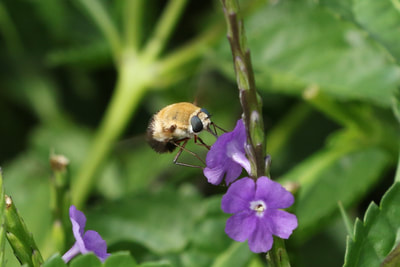Cuban Whiptail Pholidoscelis auberi was the commonest reptile here though we also saw a very large and fat Saw-scaled Curlytail Leiocephalus carinatus - I'm not sure if its a pregnant female or whether its just eaten a large meal. Many of these reptiles will eat smaller reptiles if they can catch them.
|
What we know as the 'farm on the hill' is about 4km away as the crow flies on the SW side of the Cerro de Yaguajay. It provides us with some good exercise walking up the hill and we always find something interesting. On the way up we saw our only Miami Blue Cyclargus thomasi of the trip on exactly the same bush that we found them this time last year. Gray Cracker Hamadryas februa is common in the area but flies later in the year so we have seen only small numbers so far. There were lots of Tropical Buckeye Junonia zonalis flying and I also found a small larva of this species which I only noticed while photographing a pair of Cassius Blue Leptotes cassius. Adult bee-flies of the Family Bombyliidae are mainly nectar feeders and mimic bees not only in appearance but also in their loud buzzing flight. This Batesian mimicry affords them some protection from predation. We do occasionally see bee-flies in Cuba but have never seen this one before. It was medium-sized and very loud as it moved from flower to flower on the Blue Porterweed Stachytarpheta. The larval stages (often host-specific) are predators or parasitoids of the eggs and larvae of other insects. The adult females usually deposit eggs in the vicinity of possible hosts, quite often in the burrows of beetles or wasps or solitary bees. Thank you to Julio A. Genaro who has kindly identified this as in the genus Heterostylum probably H. bicolor but he says the pale hairs on the posterior half of the abdomen is confusing as this is normally all dark brown. One of the commonest day-flying moths here is Spoladea recurvalis (Crambidae). On this trip we have seen it in quite large numbers in several places but when disturbed it invariably flies up and settles on the underside of another leaf making them difficult to photograph. Its larvae feed on many different plants including many that we humans use as food including spinach, beet, maize and soybean. We saw a single Martial Scrub-Hairstreak Strymon martialis, the only one of the trip, but it flew as soon as I pointed the camera at it. On the bird front we saw several Cuban Emerald and Cuban Tody while we could hear Cuban Trogons calling further along the hillside. Cuban Whiptail Pholidoscelis auberi was the commonest reptile here though we also saw a very large and fat Saw-scaled Curlytail Leiocephalus carinatus - I'm not sure if its a pregnant female or whether its just eaten a large meal. Many of these reptiles will eat smaller reptiles if they can catch them. We saw small numbers of Fiery Skipper Hylephila phyleus every day but I still hadn't managed to get any better pictures of them and today wasn't any different though I did see a female laying on a grass leaf. Both Northern and Louisiana Waterthrush are common winter residents and transients in Cuba. Northern Waterthrush prefer the mangrove swamps so are more coastal than Louisiana Waterthrush which prefers woodland streams and ponds. The differences in appearance can be subtle but Northern has a streaked throat, darker legs, finer bill and a supercilium that tapers behind the eye and is usually buffish (though it can be white). Louisiana Waterthrush has a white unstreaked throat, pink legs, stouter bill and a white supercilium that broadens behind the eye.
0 Comments
Leave a Reply. |
Welcome to our Blog
Here we will post interesting news about what we and others have seen in Cuba. Archives
July 2024
Categories |








 RSS Feed
RSS Feed